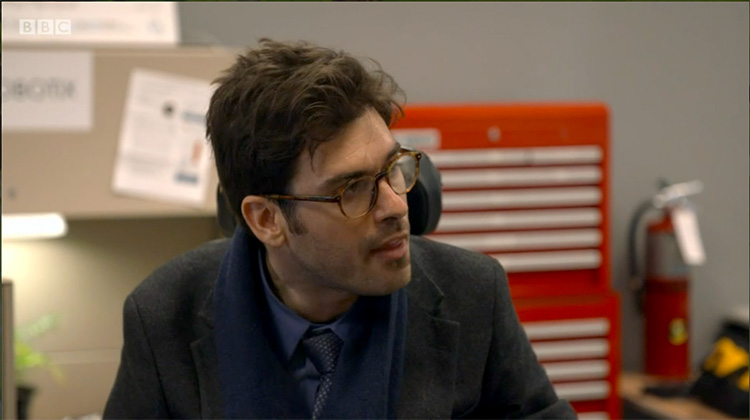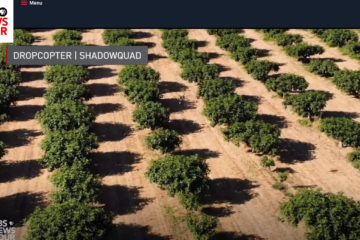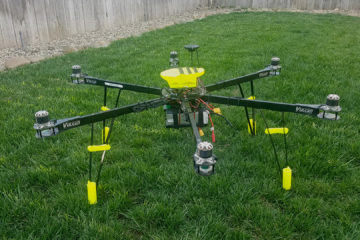See the video here: https://www.bbc.com/reel/playlist/follow-the-food
This is an excerpt from the BBC documentary “Follow the Food” in which Dropcopter and Shadowquad’s aerial footage are featured for agricultural drone pollination…
Farming is facing far more fundamental problems, however, than simply boosting the amount of food it grows. Environmental degradation caused by climate change is altering the land and weather that farmers rely upon to produce crops in the first place.
Recent studies are also revealing new challenges may lie ahead too. Declines in insects due to disease, climate change and the use of pesticides has raised the risk of a “catastrophic collapse” in pollinators that many fruit crops rely upon. Apples, almonds, blueberries, cherries, avocados, potatoes, onions, beet, rapeseed, cucumber, carrots, lemon, cranberries and grapes are just some of the foods that rely upon insects in order to produce fruit or seeds.
But it may be possible to give the insects a helping hand. Dropcopter in Syracuse, New York, is using drones to pollinate fruit and nut orchards.

Since pollinator numbers have been in decline, these orchards have had to rely on lorry-loads of honey bees that are driven all across the US to pollinate their crops. These huge swarms can efficiently do the job, but they do so to the detriment of local insects that they compete with. The cost of shipping these bees around the country – together with the uncertainty caused by diseases like Varroa Mite and Colony Collapse Disorder, which have led to honey bee numbers plummeting – have left many farmers looking for alternatives.
“We fly our drones over a row of trees and dispense a cloud of pollen that is pushed down by the rotor blades,” explains Adam Fine, co-founder and chief technology officer at Dropcopter. “The pollen sticks to the trees and it creates a feeding frenzy among the insects that live there and they move it around to pollinate the flowers further.”
The concept should avoid the need to ship truck-loads of honey bees around the country to pollinate these crops. Crucially it also helps to support local insects that the honey bees would normally compete with by providing them with a dusting of pollen to feed on. As they move around the trees, they inevitably carry some of it with them to pollinate flowers.
Over the past four years the company has dispensed pollen for 12 farmers in California and New York on a range of different crops including almonds, apples, cherries, pistachios and olives. Its drones can carry up to 2kg (4.4lb) of pollen – although rarely need to carry this much – and fly around 10ft (3m) over the tree canopy.
Research commissioned by Dropcopter suggests that its approach can increase yields by between 25-50% as it can ensure all of the trees receive pollen rather than the scattergun flight paths of honey bees. It can also reduce the need to plant alternating rows of trees – fruit producing and pollinating trees, as often trees that produce lots of pollen are not so good at producing good quality fruit. Instead farmers can focus on growing only the trees that produce the crop they want.
Although their system won’t work for crops like cranberries and blueberries, which have flowers that point downwards, Fine believes that using drones to pollinate crops could actually give insects a boost rather than replace them. “I don’t think drones will replace honey bees entirely,” he says. “But I think we are about to see a change in the way crops are pollinated that relies more on native pollinators.”
Farming is facing far more fundamental problems, however, than simply boosting the amount of food it grows. Environmental degradation caused by climate change is altering the land and weather that farmers rely upon to produce crops in the first place.
Recent studies are also revealing new challenges may lie ahead too. Declines in insects due to disease, climate change and the use of pesticides has raised the risk of a “catastrophic collapse” in pollinators that many fruit crops rely upon. Apples, almonds, blueberries, cherries, avocados, potatoes, onions, beet, rapeseed, cucumber, carrots, lemon, cranberries and grapes are just some of the foods that rely upon insects in order to produce fruit or seeds.
But it may be possible to give the insects a helping hand. Dropcopter in Syracuse, New York, is using drones to pollinate fruit and nut orchards.
Since pollinator numbers have been in decline, these orchards have had to rely on lorry-loads of honey bees that are driven all across the US to pollinate their crops. These huge swarms can efficiently do the job, but they do so to the detriment of local insects that they compete with. The cost of shipping these bees around the country – together with the uncertainty caused by diseases like Varroa Mite and Colony Collapse Disorder, which have led to honey bee numbers plummeting – have left many farmers looking for alternatives.
“We fly our drones over a row of trees and dispense a cloud of pollen that is pushed down by the rotor blades,” explains Adam Fine, co-founder and chief technology officer at Dropcopter. “The pollen sticks to the trees and it creates a feeding frenzy among the insects that live there and they move it around to pollinate the flowers further.”
The concept should avoid the need to ship truck-loads of honey bees around the country to pollinate these crops. Crucially it also helps to support local insects that the honey bees would normally compete with by providing them with a dusting of pollen to feed on. As they move around the trees, they inevitably carry some of it with them to pollinate flowers.
Over the past four years the company has dispensed pollen for 12 farmers in California and New York on a range of different crops including almonds, apples, cherries, pistachios and olives. Its drones can carry up to 2kg (4.4lb) of pollen – although rarely need to carry this much – and fly around 10ft (3m) over the tree canopy.
Research commissioned by Dropcopter suggests that its approach can increase yields by between 25-50% as it can ensure all of the trees receive pollen rather than the scattergun flight paths of honey bees. It can also reduce the need to plant alternating rows of trees – fruit producing and pollinating trees, as often trees that produce lots of pollen are not so good at producing good quality fruit. Instead farmers can focus on growing only the trees that produce the crop they want.
Although their system won’t work for crops like cranberries and blueberries, which have flowers that point downwards, Fine believes that using drones to pollinate crops could actually give insects a boost rather than replace them. “I don’t think drones will replace honey bees entirely,” he says. “But I think we are about to see a change in the way crops are pollinated that relies more on native pollinators.”



0 Comments